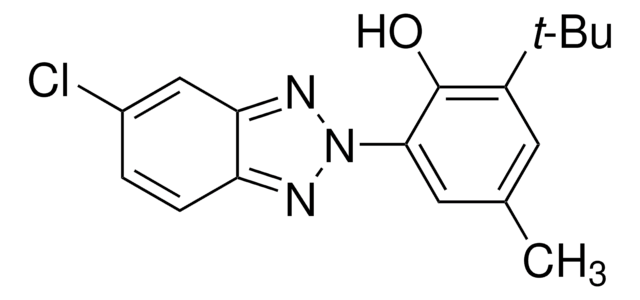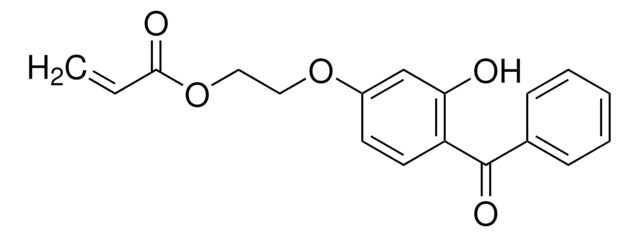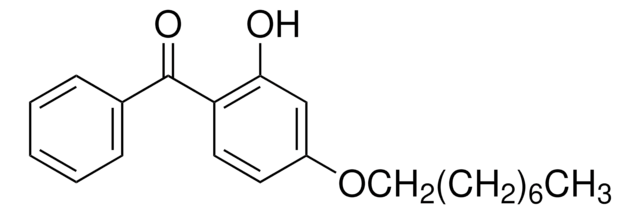413437
2-[3-(2H-Benzotriazol-2-yl)-4-hydroxyphenyl]ethyl methacrylate
99%
Synonym(s):
2-[2-Hydroxy-5-[2-(methacryloyloxy)ethyl]phenyl]-2H-benzotriazole
About This Item
Recommended Products
Quality Level
assay
99%
form
solid
mp
96-98 °C (lit.)
SMILES string
CC(=C)C(=O)OCCc1ccc(O)c(c1)-n2nc3ccccc3n2
InChI
1S/C18H17N3O3/c1-12(2)18(23)24-10-9-13-7-8-17(22)16(11-13)21-19-14-5-3-4-6-15(14)20-21/h3-8,11,22H,1,9-10H2,2H3
InChI key
VCYCUECVHJJFIQ-UHFFFAOYSA-N
Looking for similar products? Visit Product Comparison Guide
Related Categories
General description
Application
- To prepare a polymer material by copolymerization with 2-hydroxy-4-acryloyloxybenzophenone (HABP). The synthesized polymer can be applied to cotton fabric for UV protection.
- In the preparation of ultraviolet (UV) protective textiles. It is grafted onto the fabric via polymerization to create a UV-protective coating.
- As a monomer in synthesizing fluoroalkyl end-capped oligomers with good surface-active properties.
- It is also used as a UV absorber (UVAs) in intraocular lenses.
hcodes
pcodes
Hazard Classifications
Aquatic Chronic 4
wgk_germany
WGK 1
flash_point_f
Not applicable
flash_point_c
Not applicable
ppe
dust mask type N95 (US), Eyeshields, Gloves
Certificates of Analysis (COA)
Search for Certificates of Analysis (COA) by entering the products Lot/Batch Number. Lot and Batch Numbers can be found on a product’s label following the words ‘Lot’ or ‘Batch’.
Already Own This Product?
Find documentation for the products that you have recently purchased in the Document Library.
Customers Also Viewed
Articles
The manufacture of monomers for use in ophthalmic applications is driven by the need for higher purity, improved reliability of manufacturing supply, but ultimately by the need for the increased comfort, convenience, and safety of contact lens wearers. Daily wear contact lenses have the potential to fill this need for many customers; however, their widespread use is constrained by higher costs compared to weekly- or monthly-based lenses. New approaches that improve cost structure and result in higher quality raw materials are needed to help make contact lenses more affordable and accelerate growth of the contact lens market.
Our team of scientists has experience in all areas of research including Life Science, Material Science, Chemical Synthesis, Chromatography, Analytical and many others.
Contact Technical Service











